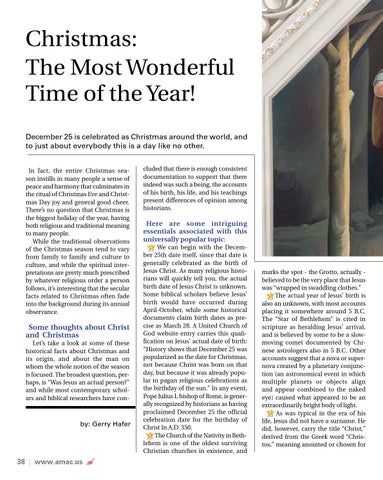Christmas: The Most Wonderful Time of the Year! December 25 is celebrated as Christmas around the world, and to just about everybody this is a day like no other. In fact, the entire Christmas season instills in many people a sense of peace and harmony that culminates in the ritual of Christmas Eve and Christmas Day joy and general good cheer. There’s no question that Christmas is the biggest holiday of the year, having both religious and traditional meaning to many people. While the traditional observations of the Christmas season tend to vary from family to family and culture to culture, and while the spiritual interpretations are pretty much prescribed by whatever religious order a person follows, it’s interesting that the secular facts related to Christmas often fade into the background during its annual observance.
Some thoughts about Christ and Christmas Let’s take a look at some of these historical facts about Christmas and its origin, and about the man on whom the whole notion of the season is focused. The broadest question, perhaps, is “Was Jesus an actual person?” and while most contemporary scholars and biblical researchers have con-
by: Gerry Hafer
38 | www.amac.us
cluded that there is enough consistent documentation to support that there indeed was such a being, the accounts of his birth, his life, and his teachings present differences of opinion among historians.
Here are some intriguing essentials associated with this universally popular topic: • We can begin with the December 25th date itself, since that date is generally celebrated as the birth of Jesus Christ. As many religious historians will quickly tell you, the actual birth date of Jesus Christ is unknown. Some biblical scholars believe Jesus’ birth would have occurred during April-October, while some historical documents claim birth dates as precise as March 28. A United Church of God website entry carries this qualification on Jesus’ actual date of birth: “History shows that December 25 was popularized as the date for Christmas, not because Christ was born on that day, but because it was already popular in pagan religious celebrations as the birthday of the sun.” In any event, Pope Julius I, bishop of Rome, is generally recognized by historians as having proclaimed December 25 the official celebration date for the birthday of Christ In A.D. 350. • The Church of the Nativity in Bethlehem is one of the oldest surviving Christian churches in existence, and
marks the spot - the Grotto, actually believed to be the very place that Jesus was “wrapped in swaddling clothes.” • The actual year of Jesus’ birth is also an unknown, with most accounts placing it somewhere around 5 B.C. The “Star of Bethlehem” is cited in scripture as heralding Jesus’ arrival, and is believed by some to be a slowmoving comet documented by Chinese astrologers also in 5 B.C. Other accounts suggest that a nova or supernova created by a planetary conjunction (an astronomical event in which multiple planets or objects align and appear combined to the naked eye) caused what appeared to be an extraordinarily bright body of light. • As was typical in the era of his life, Jesus did not have a surname. He did, however, carry the title “Christ,” derived from the Greek word “Christos,” meaning anointed or chosen for
